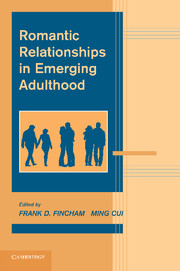Book contents
- Frontmatter
- Contents
- List of Contributors
- Foreword
- PART I INTRODUCTION
- PART II CONCEPTUAL AND METHODOLOGICAL FOUNDATIONS
- PART III THE DEVELOPMENTAL CONTEXT OF ROMANTIC RELATIONSHIPS IN EMERGING ADULTHOOD
- PART IV RELATIONSHIP PROCESSES IN EMERGING ADULTHOOD
- PART V PRACTICAL IMPLICATIONS
- 14 Romantic Relationships and Mental Health in Emerging Adulthood
- 15 Relationship Education in Emerging Adulthood: Problems and Prospects
- 16 Romantic Relationships and Academic/Career Trajectories in Emerging Adulthood
- Index
- References
16 - Romantic Relationships and Academic/Career Trajectories in Emerging Adulthood
Published online by Cambridge University Press: 06 December 2010
- Frontmatter
- Contents
- List of Contributors
- Foreword
- PART I INTRODUCTION
- PART II CONCEPTUAL AND METHODOLOGICAL FOUNDATIONS
- PART III THE DEVELOPMENTAL CONTEXT OF ROMANTIC RELATIONSHIPS IN EMERGING ADULTHOOD
- PART IV RELATIONSHIP PROCESSES IN EMERGING ADULTHOOD
- PART V PRACTICAL IMPLICATIONS
- 14 Romantic Relationships and Mental Health in Emerging Adulthood
- 15 Relationship Education in Emerging Adulthood: Problems and Prospects
- 16 Romantic Relationships and Academic/Career Trajectories in Emerging Adulthood
- Index
- References
Summary
A defining feature of emerging adulthood (roughly 18 to 25 years of age; Arnett, 2000) is gaining independence from parents, both financially and psychologically. Education and work experience are key to establishing the groundwork for successful transitions to adulthood for both men and women. Most critical transitions in education and work life occur in emerging adulthood, a time when romantic partnerships are also taken more seriously; marital prospects especially are evaluated for their economic potential. Unlike earlier generations, both men and women today are valued in the “marriage market” for their current and potential positive economic circumstances (e.g., Carlson, McLanahan, & England, 2004; Goldstein & Kenney, 2001; Sweeney & Cancian, 2004; White & Rogers, 2000). Emerging adulthood is a time period when interactions with and the influence of parents and peers wane and are to some extent supplanted by the support and influence of romantic partnerships (Collins & van Dulmen, 2006; Giordano, Phelps, Manning, & Longmore, 2008; Tanner, 2006). Thus, in emerging adulthood romantic partners are expected to play a large role that may have long-term, consequential implications on work and education prospects.
This chapter focuses on the importance of achievement and economic stability in emerging adulthood and how romantic relationships influence education and career trajectories. A multimethod approach is applied that draws on survey data from 428 currently dating young adults (aged 18 to 24) and narrative data soliciting the perspectives of 155 young adults (aged 18 to 24).
- Type
- Chapter
- Information
- Romantic Relationships in Emerging Adulthood , pp. 317 - 334Publisher: Cambridge University PressPrint publication year: 2010
References
- 8
- Cited by



